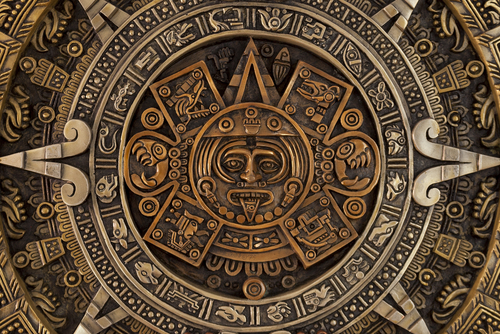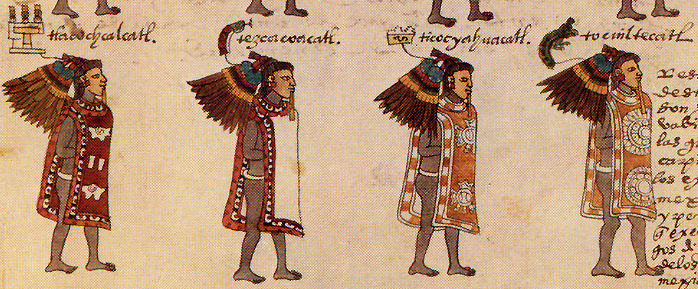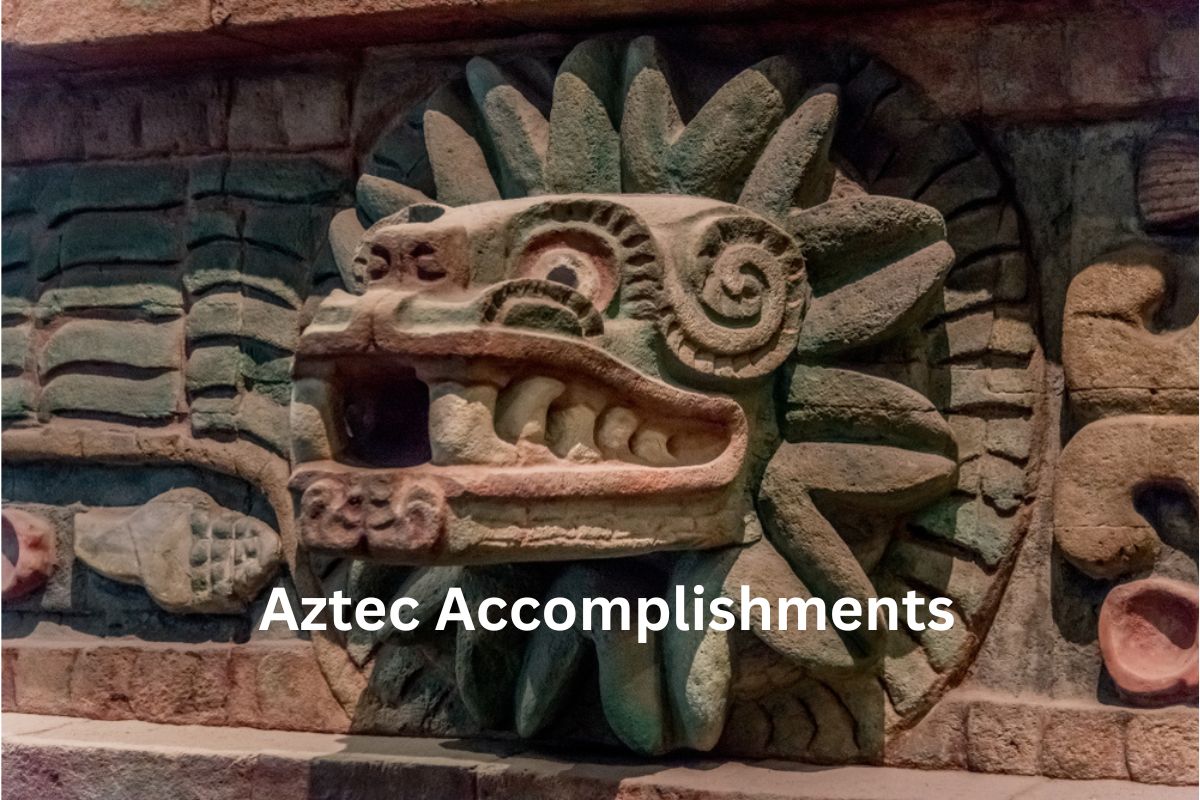The Aztecs were a vibrant and powerful Mesoamerican civilization that thrived in the 14th to 16th centuries. Centered around their majestic capital city, Tenochtitlan, the Aztecs achieved remarkable accomplishments in various fields.
Their achievements in areas such as agriculture, mathematics, art, and military prowess left a lasting impact on Mesoamerican history.
This brief introduction sets the stage for exploring the rich cultural heritage and remarkable contributions of the Aztecs to the world.
Accomplishments of the Aztecs
1. Tenochtitlan – Capital city and engineering marvel
Tenochtitlan was the heart of the Aztec Empire and one of the most impressive cities of the pre-Columbian Americas. It was founded in 1325 on a small island in Lake Texcoco.
The Aztecs ingeniously constructed their city on a series of artificial islands connected by raised causeways, allowing for easy access to the mainland. The causeways also served as dikes, helping to control the lake’s water levels.
Also Read: Facts About the Aztecs
At its peak, Tenochtitlan covered an area of about 5 square miles (13 square kilometers) and had a well-organized urban layout. The city was divided into four main districts, each with its own distinct characteristics and purposes.
The central district housed the religious and administrative buildings, including the Templo Mayor, the grand pyramid dedicated to the Aztec gods Huitzilopochtli and Tlaloc. The city’s architectural achievements impressed Spanish conquistadors upon their arrival in the early 16th century.

2. Advanced agriculture with chinampas (floating gardens)
One of the most remarkable achievements of the Aztecs was their innovative agricultural system using chinampas, also known as floating gardens. The surrounding areas of Lake Texcoco were not suitable for traditional farming due to the marshy conditions, so the Aztecs ingeniously solved this problem.
Also Read: Timeline of the Aztec Empire
Chinampas were artificial islands built on the lake’s surface by layering mud, vegetation, and reeds. These rectangular plots of fertile land were approximately 98 feet (30 meters) long and 8 feet (2.5 meters) wide.
The mud and organic materials provided excellent nutrients for crops. The Aztecs cultivated a variety of crops on chinampas, with maize (corn), beans, squash, tomatoes, chilies, and flowers being some of the main staples.
This ingenious agricultural method significantly increased crop yields and contributed to the sustenance of the large population of Tenochtitlan and the Aztec Empire as a whole. Chinampas became a vital part of their economic prosperity and food security.
3. Sophisticated calendar system for mathematics and astronomy
The Aztecs developed a complex and accurate calendar system that demonstrated their understanding of mathematics and astronomy.
They had two main calendars: the Xiuhpohualli, or solar calendar, and the Tonalpohualli, or sacred calendar. The combination of these two calendars created the “Calendar Round,” a cycle of 52 years.
The Xiuhpohualli consisted of 18 months, each with 20 days, totaling 360 days. To account for the remaining 5.25 days of the solar year, the Aztecs added a special five-day month called the “Nemontemi” at the end of the year.
The Tonalpohualli was a 260-day ritual calendar, with each day associated with a unique combination of one of the 20 named days and one of the 13 numbers. The Tonalpohualli was crucial for scheduling religious ceremonies, divination, and other significant events.
The Aztecs used these calendars to determine auspicious dates for planting and harvesting crops, organizing religious festivals, and predicting future events. Their calendar system was so accurate that it even outperformed the European calendars of that time when it came to tracking celestial events.
4. Impressive pyramids and temples showcasing architecture
Aztec architecture was characterized by monumental structures, particularly pyramids and temples, which showcased their engineering and artistic skills. The Templo Mayor, located in the center of Tenochtitlan, was the most prominent religious pyramid in the city.
It was dedicated to two major Aztec deities, Huitzilopochtli, the god of war, and Tlaloc, the god of rain and agriculture. The pyramid had two shrines at the top, each dedicated to one of these deities.
The Templo Mayor was an impressive seven-tiered structure made of stone and adorned with intricate carvings and sculptures. It was periodically expanded and rebuilt to accommodate various religious ceremonies and offerings.
The Aztecs believed that the gods required regular human sacrifices to ensure the sun’s rising and other aspects vital for the continuation of the world.
Besides religious structures, the Aztecs built impressive administrative and ceremonial buildings throughout their cities. Their architecture displayed a sense of grandeur and served as a reflection of their societal values and religious beliefs.

5. Knowledge of herbal medicine and traditional healing practices
The Aztecs had a considerable understanding of herbal medicine and traditional healing practices. Their knowledge of medicinal plants and remedies was passed down through generations and was often intertwined with religious beliefs and rituals.
Aztec healers, known as tlamatini or ticitl, played a vital role in their society. They used a vast array of plants, herbs, and natural substances to treat various illnesses and injuries. Some common medicinal plants included aloe vera, sage, cacao, and a variety of other herbs.
Apart from herbal medicine, the Aztecs practiced other forms of healing, such as massage therapy, steam baths, and spiritual rituals. They believed that a balance between the physical, mental, and spiritual aspects of a person was essential for overall well-being.
The Aztec approach to medicine and healing was holistic, considering not only the physical symptoms but also the spiritual and emotional aspects of a patient’s condition. This holistic approach was deeply integrated into their culture and belief system.
6. Skilled artists and craftsmen producing intricate artwork
Aztec art and craftsmanship flourished, leaving behind an impressive legacy of works in various media. Aztec artists were skilled in working with materials such as stone, wood, clay, feathers, textiles, and precious metals.
One of the most well-known forms of Aztec art was pottery. Aztec pottery was characterized by intricate designs and intricate geometric patterns. They used slip painting and various glazes to create visually stunning pottery pieces. These vessels served practical purposes, such as storing food and water, as well as ceremonial and decorative functions.
Featherwork was another remarkable art form mastered by the Aztecs. They created elaborate feathered headdresses, shields, fans, and other objects adorned with the brightly colored feathers of tropical birds. These feathered artworks were highly prized and reserved for religious ceremonies and nobility.
Goldsmithing and silversmithing were also well-developed crafts among the Aztecs. They created exquisite jewelry, ornaments, and ceremonial objects using these precious metals.
In addition to crafts, the Aztecs were accomplished painters and scribes. They produced elaborate illustrated manuscripts known as codices, which provided valuable insights into their history, religion, and culture.
Aztec art often featured religious themes and symbols, reflecting their devotion to the gods and their belief in the interconnectedness of the natural and spiritual worlds.
7. System of education and valuable codices for recording knowledge
The Aztecs had a system of education that focused on training different segments of their society. While formal education was primarily reserved for the elite class, knowledge was also imparted through oral traditions and practical training to other members of society.
For the elite, education was rigorous and multifaceted, involving subjects like astronomy, history, religion, politics, and military training. Boys from noble families received their education in calmecacs, religious schools, where they would learn the intricacies of their culture and religion.
On the other hand, commoner boys attended telpochcalli, where they were taught practical skills, military training, and vocational knowledge.
The Aztecs recorded much of their knowledge in codices, which were illustrated manuscripts made from paper made of fig tree bark or animal skins. These codices contained a wealth of information about history, religious rituals, calendrical systems, and more.
Unfortunately, much of this knowledge was lost during the Spanish conquest, as the conquistadors and missionaries often destroyed or banned these codices, considering them pagan works.
8. Extensive trade networks and use of cacao beans as currency
The Aztecs were skilled traders and had a well-established trade network that connected various regions of Mesoamerica. The main trade routes were by land and water, and the Aztecs traded a wide range of goods, including agricultural products, textiles, pottery, obsidian, jade, and more.
The Aztecs used a barter system for smaller transactions, where goods were exchanged directly for other goods. For larger transactions, they utilized a standardized currency known as cacao beans.
Cacao beans were highly valued and used as both currency and a luxury commodity. The beans were also used to make a bitter beverage called “xocolātl,” which was reserved for nobles and religious ceremonies.
The Aztec economy benefited from these extensive trade networks, fostering cultural exchange and contributing to the wealth and stability of their empire.
9. Powerful military and expansionist policies
The Aztecs were a formidable military force, and their expansionist policies played a crucial role in the growth of their empire. They engaged in frequent warfare to conquer and assimilate neighboring city-states into their dominion.
The Aztec military was well-organized and highly disciplined. Warriors, known as “cuāuhocēlōtl,” were drawn from all social classes and were highly respected in Aztec society. They were trained from a young age in the art of warfare, and their primary objective was to capture enemies for sacrificial rituals rather than outright extermination.
The success of their military campaigns allowed the Aztecs to expand their territory and establish tribute systems, where subjected regions would pay tribute in the form of goods and labor to the Aztec rulers. This further enriched the Aztec elite and contributed to the wealth and stability of the empire.
10. Sophisticated aqueducts and infrastructure for water supply
To support the large population of Tenochtitlan and surrounding areas, the Aztecs developed a sophisticated system of aqueducts and canals to ensure a stable water supply. Lake Texcoco, the site of Tenochtitlan, was surrounded by marshes and often flooded, making it necessary to manage water effectively.
The Aztecs built aqueducts, known as “zanjas,” to channel freshwater from springs and distant sources into the city. These aqueducts were supported by elevated bridges, allowing water to flow freely over the city’s causeways.
Additionally, the Aztecs constructed a system of dikes and raised roads that helped control the water levels in Lake Texcoco and protect the city from flooding during the rainy season.
This advanced water management system showcased the Aztecs’ engineering prowess and enabled them to sustain a large population in a challenging environment.
